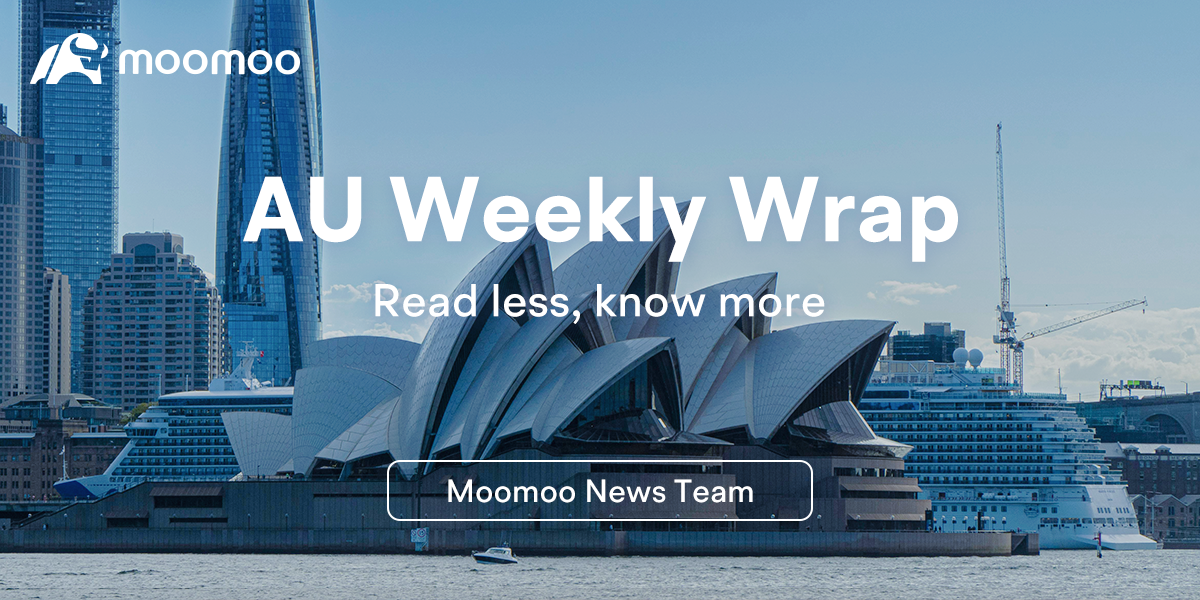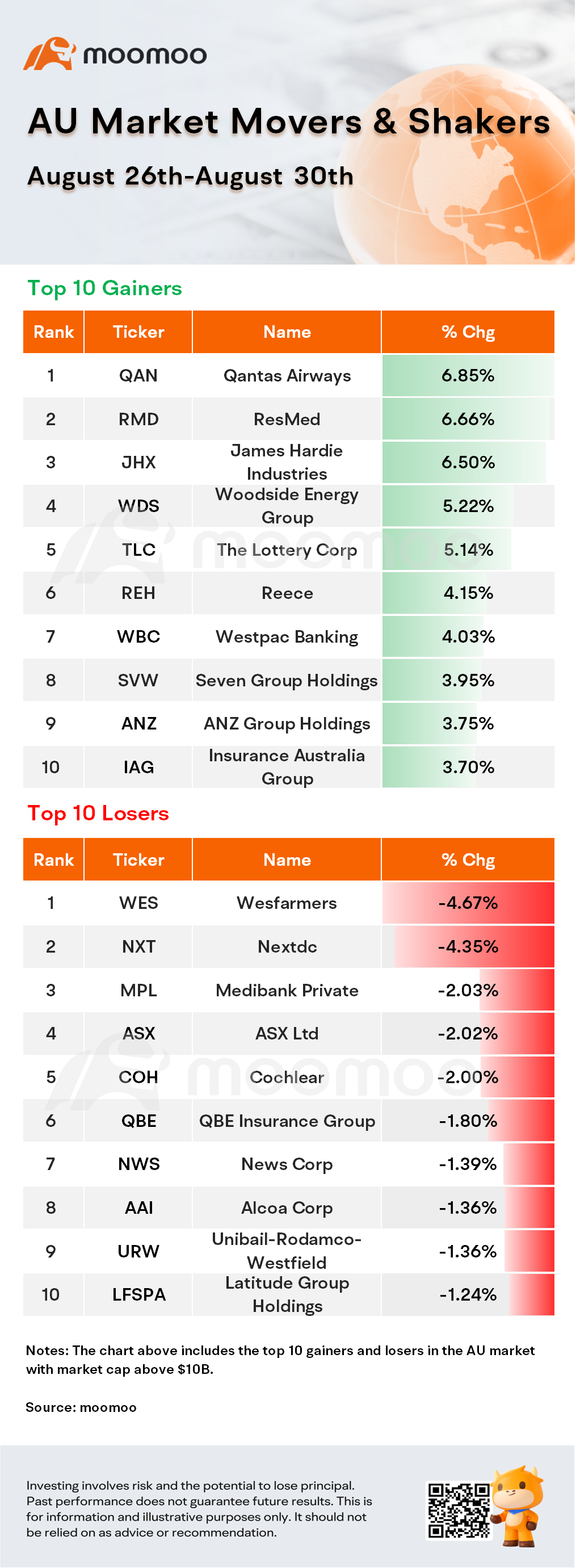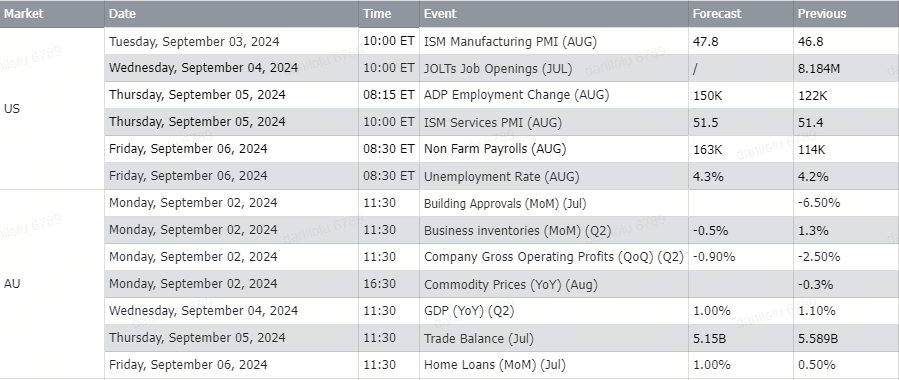AU Weekly Wrap | ASX Nears Record High Amid Mixed Earnings; July PCE Inflation Report Supports Fed's Rate-Cut Path

The Australian sharemarket closed near a record high on Friday, bolstered by rising oil prices and a late surge of better-than-expected earnings results, marking the benchmark's third consecutive week of gains.
Macro News
Inflation increased slightly in July, aligning with the Federal Reserve's preferred measure as it prepares for its first interest rate cut in over four years. The Commerce Department reported a 0.2% monthly rise in the personal consumption expenditures (PCE) price index and a 2.5% annual increase, matching expectations. Core PCE, excluding food and energy, also rose 0.2% monthly and 2.6% annually, slightly below the 2.7% estimate. Both core and headline inflation remained unchanged from June. Markets are certain of a rate cut in September, with debate over whether it will be a quarter or half-point reduction. Fed officials, including Chair Jerome Powell, are confident that inflation is nearing the 2% target. The Fed is now expected to balance its focus on lowering inflation with supporting the labor market, as unemployment, though low at 4.3%, has been rising and hiring appears to be slowing.
Australia's consumer price index (CPI) inflation rose more than expected in July, driven by higher fresh food costs, though softer housing and energy costs led to a slight decline in core inflation. CPI inflation increased by 3.5% year-on-year, above the expected 3.4% but down from June's 3.8%. Core CPI inflation, excluding volatile items, dropped to 3.7% from 4%. Despite the decline, inflation remains above the Reserve Bank of Australia's (RBA) 2% to 3% target, fueling concerns of potential rate hikes. RBA officials recently suggested that further rate increases might be necessary to combat persistent inflation. Analysts predict that rates will remain high until at least late 2025.
Australian retail sales stagnated in July after a few months of growth driven by discounting events. According to the Australian Bureau of Statistics, retail sales remained unchanged from June, which saw a 0.5% rise. Analysts had expected a 0.3% increase. Year-over-year, sales were up 2.3%, falling short given the country's 2.6% annual population growth. Spending on clothes and at department stores declined as consumers became more frugal.
$National Australia Bank Ltd (NAB.AU)$ CEO Andrew Irvine highlighted increasing economic divisions in Australia, complicating monetary policy decisions. Speaking to the House of Representatives Economics Committee, Irvine noted a booming profit for resource firms while housing shortages present major social issues. He emphasized that while Australia’s economy grows at 1.5%, this average masks regional disparities, with areas like Victoria suffering more due to correlations with domestic demand and interest rates. Irvine's insights recall past economic splits during the mining boom. As interest rates affect regions unevenly, many NAB customers face tough spending decisions. Irvine's testimony follows recent remarks from other major bank CEOs addressing regulatory concerns and industry challenges.
Company News
In August, major ASX miners BHP Group, Rio Tinto, Fortescue, and Pilbara Minerals reported their earnings, highlighting their status as profitable, mature businesses. Despite strong historical performance, these giants saw declines in 2024: BHP and Rio Tinto each fell over 10% year-to-date, Pilbara dropped more than 20%, and Fortescue declined over 30%. These declines were driven by sharp fluctuations in commodity prices, particularly lithium, and concerns about a slower-than-expected global economic recovery, notably from China.
$Fortescue Ltd (FMG.AU)$ reported its FY24 results with key metrics: ore mined and processed both down 1%, revenue up 8% to $18.2 billion, net profit after tax up 18% to $5.66 billion, and underlying EPS up 3% to $1.85 per share. The final fully franked dividend is 89 AUD cents per share, down 11% year-over-year. Despite higher costs from labor rates and mine plan changes, Fortescue achieved its third-highest annual earnings, supported by a stable iron ore price.
$BHP Group Ltd (BHP.AU)$ reported a 39% drop in statutory net profit to $7.9 billion due to a $2.7 billion writedown in its Western Australian nickel operations and a $3.8 billion charge from the Samarco dam failure in Brazil. However, underlying profit rose 2% to $13.7 billion, exceeding expectations, and revenue increased 3% to $55.7 billion, driven by higher iron ore and copper prices. The final dividend was cut to 74 US cents per share from 80 US cents. BHP expects challenging economic conditions in FY25 but remains confident due to its high-quality assets. CEO Mike Henry anticipates near-term market volatility, particularly with China's uneven recovery.
On August 26th, $Pilbara Minerals Ltd (PLS.AU)$, a leading lithium company on the ASX, reported its financial results for the fiscal year ending June 30, 2024. Despite a 69% drop in revenue and an 86% decline in profit due to weak lithium prices, Pilbara Minerals' shares still saw an increase following the earnings announcement.
AU Market Weekly Movers

Upcoming Economic Events

Source: Investing.com, AFR. CNBC
Disclaimer: Moomoo Technologies Inc. is providing this content for information and educational use only.
Read more
Comment
Sign in to post a comment
